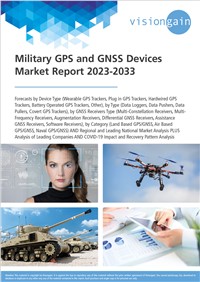This report will prove invaluable to leading firms striving for new revenue pockets if they wish to better understand the industry and its underlying dynamics. It will be useful for companies that would like to expand into different industries or to expand their existing operations in a new region.
Heavy Reliance of the Military Sector on GPS and GNSS Devices Driving Market Growth
GPS and GNSS devices have become essential for military operations, providing location, navigation, and timing information to military personnel, vehicles, and weapons systems. The military relies on GPS and GNSS for a wide range of applications, including reconnaissance, surveillance, target acquisition, and communication. As a result, any disruption or failure of GPS or GNSS systems could have serious consequences for military operations. To mitigate this risk, the military has implemented various measures, including developing backup systems and improving jamming and spoofing detection capabilities. However, with the increasing reliance on GPS and GNSS systems in military operations and the growing complexity of military equipment, the demand for more advanced and robust GPS and GNSS devices is likely to continue to grow.
Several companies are invested in producing robust and precise devices for military and defence. Some of the major companies are Raytheon Technologies, Lockheed Martin Corporation, Thales Group, BAE Systems, Northrop Grumman Corporation, Collins Aerospace, Garmin International, Rockwell Collins, Inc., L3Harris Technologies, and NovAtel Inc.
Evolving Cybersecurity Risks can Compromise GPS Signals
Cybersecurity risks can have serious consequences for military operations, which is why it is essential to take steps to mitigate them. This could involve implementing encryption and authentication protocols, using anti-jamming technologies, and monitoring GPS and GNSS signals for signs of interference or tampering. Some examples of cybersecurity risks include spoofing attacks, jamming attacks, and physical tampering among others.
What Questions Should You Ask before Buying a Market Research Report?
- How is the military GPS and GNSS devices market evolving?
- What is driving and restraining the military GPS and GNSS devices market?
- How will each military GPS and GNSS devices submarket segment grow over the forecast period and how much revenue will these submarkets account for in 2033?
- How will the market shares for each military GPS and GNSS devices submarket develop from 2023 to 2033?
- What will be the main driver for the overall market from 2023 to 2033?
- Will leading military GPS and GNSS devices markets broadly follow the macroeconomic dynamics, or will individual national markets outperform others?
- How will the market shares of the national markets change by 2033 and which geographical region will lead the market in 2033?
- Who are the leading players and what are their prospects over the forecast period?
- What are the military GPS and GNSS devices projects for these leading companies?
- How will the industry evolve during the period between 2023 and 2033? What are the implications of military GPS and GNSS devices projects taking place now and over the next 10 years?
- Is there a greater need for product commercialisation to further scale the military GPS and GNSS devices market?
- Where is the military GPS and GNSS devices market heading and how can you ensure you are at the forefront of the market?
- What are the best investment options for new product and service lines?
- What are the key prospects for moving companies into a new growth path and C-suite?
You need to discover how this will impact the military GPS and GNSS devices market today, and over the next 10 years:
- Our 353-page report provides 141 tables and 202 charts/graphs exclusively to you.
- The report highlights key lucrative areas in the industry so you can target them – NOW.
- It contains in-depth analysis of global, regional and national sales and growth.
- It highlights for you the key successful trends, changes and revenue projections made by your competitors.
This report tells you TODAY how the military GPS and GNSS devices market will develop in the next 10 years, and in line with the variations in COVID-19 economic recession and bounce. This market is more critical now than at any point over the last 10 years.
Forecasts to 2033 and other analyses reveal commercial prospects
In addition to revenue forecasting to 2033, our new study provides you with recent results, growth rates, and market shares.
You will find original analyses, with business outlooks and developments.
Discover qualitative analyses (including market dynamics, drivers, opportunities, restraints and challenges), cost structure, impact of rising military GPS and GNSS devices prices and recent developments.
This report includes data analysis and invaluable insight into how COVID-19 will affect the industry and your company. Four COVID-19 recovery patterns and their impact, namely, “V”, “L”, “W” and “U” are discussed in this report.
Segments Covered in the Report
Device Type Outlook
- Wearable GPS Trackers
- Plug in GPS Trackers
- Hardwired GPS Trackers
- Battery Operated GPS Trackers
- Other Device Type
Type
- Data Loggers
- Data Pushers
- Data pullers
- Covert GPS trackers
GNSS Receiver Type
- Multi-Constellation Receivers
- Multi-Frequency Receivers
- Augmentation Receivers
- Differential GNSS Receivers
- Assistance GNSS Receivers
- Software Receivers
Category
- Land Based GPS/GNSS
- Air Based GPS/GNSS
- Naval GPS/GNSS




